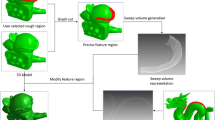Abstract
Applying sweep operations on 2-D closed contours is a well known method for modelling 3-D solid objects. This paper deals with the implementation of a solid modeler with sweep as the basic representational scheme. In the modeler, a solid is defined by sweeping a planar polygon along a linear or curved trajectory. A sculptured solid may also be defined by using a beta-spline curve for the sweep polygon and a cubic B-spline curve for the sweep trajectory. By incorporating Boolean operations, a hybrid sweep-CSG solid modeler is implemented. The current implementation allows translational, rotational, and twisted sweep operations on a planar polygon composited of lines and arcs. In addition, a solid primitive can also be created by sweeping a planar closed beta-spline curve along a cubic B-spline curve.
Similar content being viewed by others
References
Miyamoto, E.; Binford, T.O. (1975) Display generated by a generalized cone representation, Proceedings of the Conference on Computer Graphics, Pattern Recognition, & Data Structure, May, 385–387.
Agin, G.J.; Binford, T.O. (1976) Computer description of curved objects, IEEE Transactions on Computers, Vol, C-25, No. 4, April, 439–449.
Brooks, R.A. (1981) Symbolic reasoning among 3-D models and 2-D images, Artificial Intelligence Vol. 17, 285–348.
Klok, F. (1986) Two moving coordinate frame for sweeping along a 3-D trajectory, Computer Aided Geometric Design Vol 3, 217–229.
Shani, U.; Ballard, D.H. (1984) Splines as embeddings for generalized cylinders, Computer Vision, Graphics, and Image Processing 27, 127–156.
Coquillart, S. (1987) A control-point-based sweeping technique, IEEE Computer Graphics & Applications, Nov, 36–45.
Shiroma, Y.; Okino N.; Kakazu, Y. (1982) Research on 3-D geometric modeling by sweep primitives, Proceedings, CAD-82, 671–685.
Woodwark, J.R.; Wallis, A.F. (1982) Graphical input to a Boolean solid modeller, Proceedings, CAD-82, 681–688.
Vossler, Donald L. (1985) Sweep-to-CSG conversion using pattern recognition techniques, IEEE Computer Graphics & Applications, Aug. 61–68.
Rossignac, J.R. (1985) Blending and offsetting solid models, Ph.D.Dissertation, Department of Electrical Engineering, University of Rochester, July.
Evan, R.C.; Koppelman, G.; Rajan, V.T. (1987) Shaping geometric objects by cumulative translational sweeps. IBM Journal of Research and Development Vol. 31, No. 3, May, 343–360.
Boyse, J.W. (1979) Interference detection among solids and surfaces, Communications of the ACM, Jan, Vol. 22, No. 1, pp. 3–9.
Sungurtekin, U.; Voelcker, H.B. (1986) Graphical simulation and automatic verification of NC machining programs, Proc. of IEEE Int. Conf. on Robotics and Automation, New York, 156–165.
Wang, W.P.; Wang, K.K. (1986) Geometric modelling for swept volume of moving solids. IEEE Computer Graphics and Application, Oct, 8–17.
Hui, K.C. (1990) Solid modelling and its application in mould design—a sweep primitive approach, Ph.D. Dissertation, University of Hong Kong.
Requicha, A.A.G. (1980) Representation for rigid solids: theory, methods and systems, ACM Computer Survey, Vol. 12, No. 4, 437–464.
Baer, A.; Eastman, C.; Henrion, M. (1979) Geometric modelling: a survey, Computer Aided Design, Vol. 11, No. 5, 253–272.
Roth, S.D. (1982) Ray casting for modeling solids, Computer Graphics & Image Processing, Vol. 18, No. 2, Feb 109–144.
Lee, Y.T.; Requicha, A.A.G. (1982) Algorithms for computing the volume and other integral properties of solids: I. known methods and open issues, Communications of ACM, Vol 25, No. 9, Sept. 635–642.
Lee, Y.T.; Requicha, A.A.G. (1982) Algorithms for computing the volume and other integral properties of solids: II. a family of algorithms based on representation conversion and cellular approximation, Communications of ACM, Vol 25, No. 9, Sept, pp. 642–650.
Hunt, W.A.; Volecker H.B. (1982) An exploratory study of automatic verification of program for numerically controlled machine tools, Technical Memo, No. 34, University of Rochester, Production Automation Project.
Requicha, A.A.G. (1984) Boolean operations in solid modelling: boundary evaluation and merging algorithms, Technical Memo. No. 26, Production Automation Project, University of Rochester.
Wilson, P.R. (1985) Euler formulas and geometric modelling, IEEE Computer Graphics and Applications, Vol. 5, No. 8, August, 24–36.
Faux, I.D.; Pratt, M.J. (1979) Computational Geometry for Design and Manufacture, New York: John Wiley and Sons
Tilove, R.B. (1980) Set membership classification: a unified approach to geometric intersection problems, IEEE Trans. on Computers, Vol. C-29, No. 10, Oct, 874–883.
Tiller, W. (1983) Rational B-spline for curve and surface representation, IEEE Computer Graphics & Applications, Sept, 61–69.
Piegl, L.; Tiller W. (1987) Curve and surface constructions using rational B-spline, Computer Aided Design, Vol. 19, Nov, 485–498.
Barsky, B.A.; DeRose, T.D. (1985) The beta2-spline: a special case of the beta-spline curve and surface representation. IEEE Computer Graphics & Application, Sept. 46–58.
Barsky, B.A. (1981) The beta-spline: a local representation based on shape parameters and fundamental geometric measure, Ph.D. Dissertation, University of Utah, Salt Lake City, Dec.
Barsky, B.A. (1983) Local control of bias and tension in beta-splines, ACM Transactions on Graphics, Vol. 2, No. 2, April, 109–134.
Ronald, N.G. (1986) Urn models and beta-splines, IEEE Computer Graphics & Applications, Feb. 57–64.
Goodman, T.N.T.; Unsworth, K. (1986) Manipulating shape and producing geometric continuity in β-spline curves, IEEE Computer Graphics & Applications, Feb. pp. 50–56.
Riesenfeld, R.F. (1973) Applications of B-spline approximation to geometric problems of computer-aided design, Ph.D. Dissertation, Syracuse University, May.
Tan, S.T.; Yuen, M.M.F.; Hui, K.C. (1987) Modelling solids with sweep primitives, Computers in Mechanical Engineering, Vol. 6, No. 2, Sept, 60–73.
Author information
Authors and Affiliations
Rights and permissions
About this article
Cite this article
Hui, K.C., Tan, S.T. Construction of a hybrid sweep-CSG modeler—The sweep-CSG representation. Engineering with Computers 8, 101–119 (1992). https://doi.org/10.1007/BF01200106
Issue Date:
DOI: https://doi.org/10.1007/BF01200106




